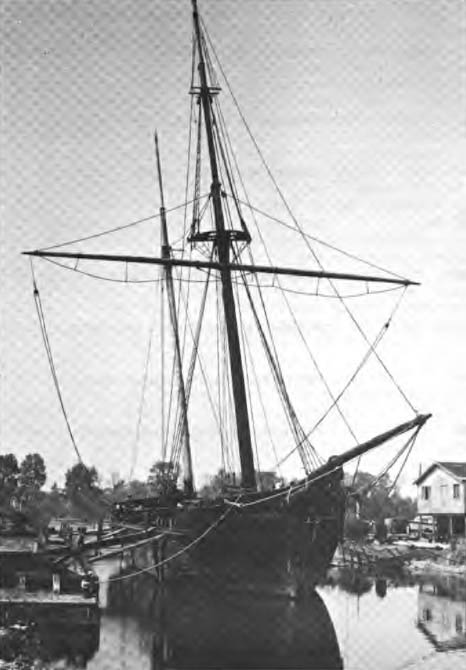
“Leave well enough alone” is an expression. This easily applied to the Alvin Clark, a schooner that sailed the Great Lakes for two decades in the 1800s. It was built in 1846 or 1847 and sank in Green Bay during a storm in 1864. It was salvaged in 1969 and moored on the Menominee River at the Mystery Ship Seaport in Menominee, Michigan.
Alvin Clark was a 105-foot-long (32-meter-long) square-stern lumber schooner with a beam of 25 feet (8 meters) and a displacement of 218 tons. It was made mostly of white oak, with 2+12-inch (63.5 mm) planking and 10-inch (254 mm)-wide ribs. The ship had a single deck, two masts, including a mainmast of 110 feet (34 meters), and was rigged as a brigantine with a square foremast.
On June 19, 1864, the ship was sailing empty through Lake Michigan to Oconto, Wisconsin, to pick up a load of lumber. As the ship approached Green Bay, Captain Dunnin ordered the holds cleaned and the hatches removed. A sudden storm capsized the ship just off the coast of Green Bay’s Chambers Island. Captain Dunnin, the mate, and another sailor drowned, but two other sailors were saved. A few months after the wreck, an attempt was made to salvage the ship, but it was unsuccessful, and the Alvin Clark was abandoned on the lakebed.
In 1967, a commercial fisherman hired sport diver Frank Hoffman to free nets that had become entangled on a “unknown obstruction” beneath the surface of Green Bay. Hoffman dove in and discovered the nets tangled in what appeared to be the mast of a ship. Hoffman initially referred to the wreck as “the Mystery Ship at 19 Fathoms,” but the ship was later identified as the Alvin Clark, thanks to a stencil made below decks by one of the sailors. The ship was completely intact and in excellent condition, and Hoffman obtained salvage rights the following year. He assembled a salvage team that recovered artifacts and removed silt from the wreck.
According to historian Theodore Karamanski, the Alvin Clark was the “finest preserved historic vessel in the United States” at the time. It was completely intact, with some mechanical systems still operational and a variety of preserved artifacts. Even after the water was pumped out of the holds, the ship remained afloat. Hoffman berthed the ship in Menominee, cleaning and re-rigging it before easing it into an earthen slip. Hoffman built a museum nearby and displayed the ship as a tourist attraction at Menominee’s “Mystery Ship Seaport” on Sixth Street. The ship was designated a Michigan State Historic Site in 1972 and a National Register of Historic Places member in 1974.
Alvin Clark began to deteriorate almost immediately after being freed from the cold, low-oxygen waters at the bay’s bottom. The museum’s earnings did not cover Hoffman’s $300,000 debt, let alone provide restoration funds. The ship eventually deteriorated to the point where it could no longer be restored. In 1985, an inebriated Hoffman attempted to burn what was left of the ship with kerosene, but he was apprehended and sentenced to a week in prison and a year on probation. He sold the ship, now a hulk, to a group of local investors in 1987 for $117,000. The investors relocated and stabilized the ship, but they were unable to adequately protect it. The ship was eventually determined to be beyond repair and declared a public hazard. The Mystery Ship Seaport and the Alvin Clark were demolished in 1994 to make way for a parking lot.
What happens to waterlogged wood?
Uncontrolled drying of wet wood causes evaporation, and when water evaporates, it exerts surface tension. This can cause the wood to split, twist, and even shrink, and if left unchecked, the wood will develop cracks and disintegrate, resulting in the loss of valuable information and even entire artifacts.
At the time, the Alvin Clark was regarded as the best preserved historic vessel in the United States. It was completely intact, with some mechanical systems still operational and a variety of preserved artifacts, but once freed from Lake Michigan’s cold, low oxygen waters, its fate became a parking lot.




